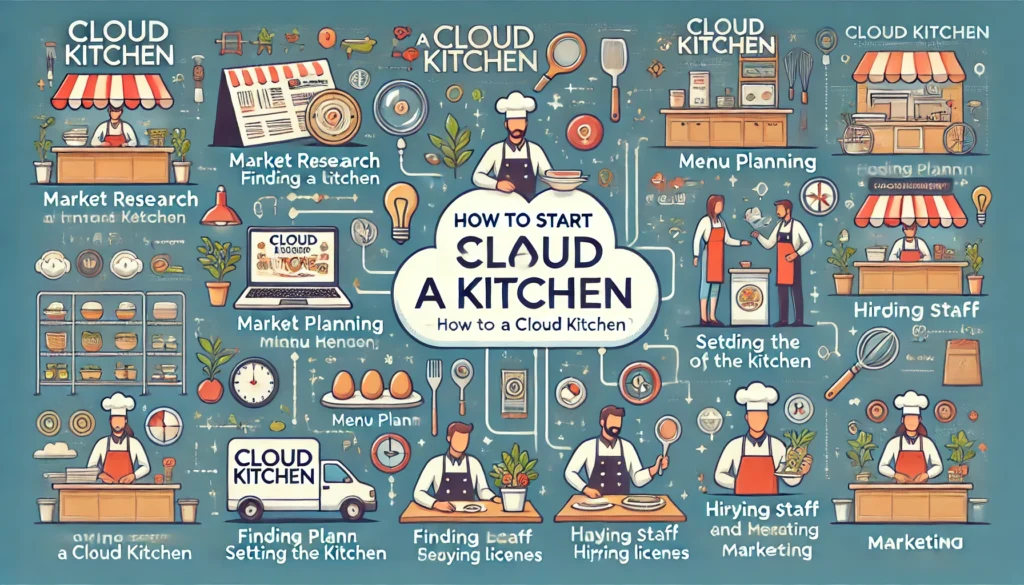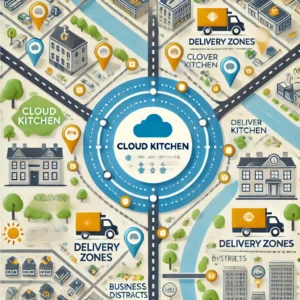Are you dreaming of starting a food business but worried about the high costs and risks of a traditional restaurant? Don’t look any further! cloud kitchens, which are also called “Virtual kitchens,” are a new way to solve your problem. In this article, we’ll explore how to start cloud kitchen with 10 easy ways to fix your food business today.
We’ll go over all the important steps you need to take for success in the challenging food business, from researching the market to getting feedback from customers. This comprehensive guide is meant to give you useful information that you can use right away to make sure your cloud kitchen is ready to go from the start.
The Concept of Cloud Kitchens
In cloud kitchens, food is made in professional kitchens that are built to deliver food. They don’t have an eating area or storefront like traditional restaurants do, which makes them much cheaper to run. These kitchens thrive in the era of online food delivery, capitalizing on the convenience that consumers seek.
Benefits of Starting a Cloud Kitchen
- Lower Overhead Costs: Without the need for a prime location or dining space, cloud kitchens save on rent, utilities, and front-of-house staff.
- Operational Efficiency: Streamlined operations focused solely on food production lead to faster preparation times and higher efficiency.
- Scalability: Cloud kitchens can easily scale operations by adding new brands or expanding delivery zones without significant investment.
- Market Reach: By partnering with multiple delivery platforms, cloud kitchens can reach a broader audience than traditional restaurants.
Step-by-Step Guide How to Start Cloud Kitchen

1. Research Your Market
Understanding your market is the first critical step in starting a cloud kitchen. Knowing the demand for different types of cuisine in your area and understanding your target audience’s preferences can help you tailor your offerings.
Understanding Demand
- Conduct surveys, use online tools, and analyze trends to gauge what potential customers are looking for in a cloud kitchen.
- Consider dietary preferences, popular cuisines, and meal types. For example, if you find a high demand for vegan options, you can focus your menu on plant-based dishes.
Analyzing Competitors
- Look at what existing cloud kitchens and traditional restaurants are offering.
- Identify gaps in the market that your cloud kitchen can fill. This analysis will help you position your business uniquely. For instance, if competitors lack late-night delivery, you can cater to that niche.
2. Create a Business Plan
A well-structured business plan is essential for the success of any business, and a cloud kitchen is no exception.
Defining Your Concept
- Clearly outline your cloud kitchen’s concept, including the type of cuisine, target audience, and unique selling points.
- A strong concept will guide your branding and marketing efforts.
Financial Planning
- Estimate your startup costs, ongoing expenses, and projected revenue.
- Consider costs for kitchen setup, ingredients, marketing, and delivery services. Ensure your plan includes financial projections and break-even analysis.
- Factor in costs for essential kitchen equipment like a commercial oven.
3. Choose the Right Location for Cloud Kitchen
Even in a cloud kitchen, picking the right spot is very important. You don’t need a great storefront, but you do need a place that is easy for your delivery employees to get to and has the right infrastructure.
Virtual vs. Physical Kitchen
- Decide whether you want a fully virtual kitchen or a physical space with delivery capabilities.
- Each has its pros and cons, depending on your business model and target market.
Licensing and Permits
- Ensure you obtain all necessary licenses and permits required for operating a cloud kitchen in your area.
- This includes health department permits, business licenses, and food handler certifications.
4. Develop a Menu for Cloud Kitchen
Your menu is the heart of your cloud kitchen. Design a menu that is appealing, practical for delivery, and cost-effective.
Designing for Delivery
- Choose dishes that travel well and maintain their quality during delivery.
- Consider packaging solutions that keep food fresh and presentable. For example, investing in high-quality insulated food delivery bags can ensure your food arrives hot and in perfect condition.
Sourcing Ingredients
- Source high-quality ingredients at a reasonable cost.
- Establish relationships with reliable suppliers to ensure consistency in your food quality.
5. Set Up Your Kitchen
Setting up your kitchen efficiently can make a big difference in your cloud kitchen’s success.
Equipment Essentials
- Invest in essential kitchen equipment that suits your menu.
- Ensure you have all necessary tools and appliances to prepare your dishes efficiently. Consider items like a commercial refrigerator and a professional-grade blender.
Safety and Hygiene
- Maintain high standards of safety and hygiene in your kitchen.
- This includes regular cleaning, proper food storage, and adherence to health regulations.
- Using products like a kitchen sanitation kit can help ensure your kitchen remains clean and safe.
Case Study: Tasty Bites Cloud Kitchen
Tasty Bites is a cloud kitchen that started in a small city with a high demand for quick, quality meals. The founder, Sarah, identified a gap in the market for late-night healthy food options.
Background
- Sarah conducted extensive market research and created a business plan focusing on healthy, late-night meals.
- She chose a central location that was cost-effective and easily accessible for delivery drivers.
- Sarah developed a menu with dishes that traveled well, sourced fresh ingredients, and set up her kitchen with essential equipment from Amazon.
Marketing and Growth
- Sarah used social media marketing to reach her target audience and partnered with local gyms and health clubs for cross-promotion.
- She signed up with popular delivery platforms and negotiated favorable terms.
- Within six months, Tasty Bites gained a loyal customer base and expanded its delivery range.
- Sarah’s emphasis on continuous improvement and customer feedback helped her refine her offerings and grow her business sustainably.
By following a strategic approach and leveraging market insights, Sarah successfully established and grew her cloud kitchen, Tasty Bites, proving the effectiveness of the outlined steps.
6. Build a Strong Brand
A strong brand identity will help your cloud kitchen stand out in a crowded market.
Creating a Logo and Name
- Choose a memorable name and design a logo that reflects your brand’s personality.
- Ensure your branding is consistent across all platforms.
Establishing an Online Presence
- Create a professional website and social media profiles.
- Use these platforms to showcase your menu, share updates, and engage with customers.
7. Implement a Marketing Strategy
Effective marketing can significantly boost your cloud kitchen’s visibility and customer base.
Social Media Marketing
- Utilize social media to reach a wider audience.
- Share engaging content, run promotions, and interact with your followers to build a loyal customer base.
- Platforms like Instagram and Facebook are excellent for showcasing your dishes and special offers.
Local Advertising
- Use local advertising methods such as flyers, local SEO, and partnerships with nearby businesses to attract customers in your area.
8. Partner with Delivery Services
Partnering with the right delivery services is essential for a cloud kitchen.
Choosing the Right Platforms
- Evaluate different delivery platforms based on their reach, fees, and reliability.
- Choose platforms that align with your business goals and customer base. Popular options include Uber Eats, DoorDash, and Grubhub.
Negotiating Terms
- Negotiate favorable terms with delivery platforms.
- Consider factors like commission rates, delivery areas, and promotional opportunities.
9. Manage Your Finances
Effective financial management is crucial for the sustainability of your cloud kitchen.
Tracking Expenses and Revenue
- Keep a close eye on your expenses and revenue.
- Use accounting software to track your financials and make informed decisions.
Optimizing Costs
- Identify areas where you can cut costs without compromising on quality.
- This could include negotiating better deals with suppliers or optimizing your menu to reduce waste.
10. Gather Feedback and Improve
Continuous improvement based on customer feedback can help your cloud kitchen thrive.
Customer Reviews
- Encourage customers to leave reviews and provide feedback.
- Use this information to identify areas for improvement and enhance your offerings.
- Platforms like Yelp and Google Reviews can be invaluable for gathering customer insights.
Continuous Improvement
- Regularly review your operations and make necessary adjustments.
- Stay updated with industry trends and adapt your business strategies accordingly.
Conclusion
In conclusion, starting a cloud kitchen can be a rewarding venture if approached with careful planning and execution. By following these 10 easy ways, you can fix your food business and set it on the path to success. Remember, continuous improvement and adaptation are key to staying competitive in the dynamic food industry. So, start your cloud kitchen journey today and make your culinary dreams a reality.


